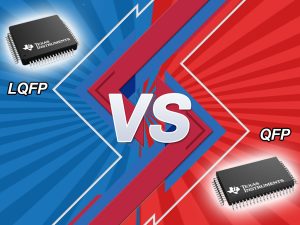
In electronics, IC packaging matters. It affects performance, size, and cost. Quad Flat Packages (QFP) and Low-Profile Quad Flat Packages (LQFP) are common in surface-mount technology (SMT). They look similar, but have key differences. Knowing these helps engineers choose the right package.
The Foundation: What is a Quad Flat Package (QFP)?
A QFP is a surface-mount IC package. It’s square with “gull-wing” leads on all four sides. These leads solder directly onto a PCB. QFPs hold many pins. They’re good for microcontrollers, memory, and digital signal processors. They balance mechanical, thermal, and electrical performance. Plus, they allow optical inspection during assembly.
Introducing the Low-Profile Variation: What is LQFP?
LQFP is a QFP variant. Its main feature is its reduced height. A standard QFP can be up to 4.0 mm thick. An LQFP is thinner, often 1.4 mm max. This lower profile comes from a special leadframe design.
Key Differences Between QFP and LQFP:
Both are QFP family members. But their designs suit different engineering needs:
- Height/Profile: This is the big one. LQFP is for limited vertical space. Its “low profile” is perfect for thinner devices.
- Pin Count and Density: Both have many pins. LQFP often has higher pin density in the same space. This is due to an optimized leadframe and finer lead pitch. More I/Os fit in a compact form factor. Standard QFPs have 100 to 256 pins. LQFPs offer up to 208 pins, often more space-efficiently.
- Applications:
- QFP: Versatile and widely used. It’s for devices where height isn’t the main concern. Examples include general-purpose microcontrollers and audio/video processing ICs.
- LQFP: Best for thinner devices. Think laptops, portable electronics, and compact communication gadgets. Board density and slim profiles are key here.
- Thermal Performance: Both offer decent thermal performance. Both can have an “Exposed Pad” (ePad) option. An ePad under the package solders to the PCB. This greatly improves heat dissipation. It’s good for high-performance or power-limited uses.
Why Do These Differences Matter?
Choosing between QFP and LQFP depends on product design needs:
- Space Constraints: For ultra-thin devices, LQFP wins.
- Cost-Effectiveness: Both are generally cost-effective for surface-mount use.
- Performance Requirements: LQFP’s compact size might affect heat without an ePad. But ePad versions fix this for higher power. Shorter leads in some QFP variants can boost electrical performance. They reduce signal delays and EMI.
- Manufacturing and Assembly: Both suit automated surface-mount assembly. However, LQFP’s finer lead pitches may need more precise soldering.
Both QFP and LQFP are vital IC packaging techs. QFP is a robust standard. LQFP offers a crucial edge when low profile and high pin density are critical. Knowing these details helps engineers optimize product design, performance, and manufacturing.
